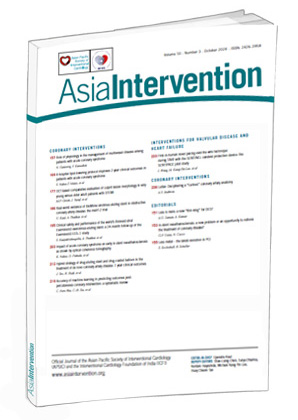The quote “less is more” was made famous by the designer and architect Ludwig Mies van der Rohe and came to define the ideals of modernist design and architecture. This quote aptly describes the evolution of coronary stents. Since the first report of increased rates of stent thrombosis with first-generation drug-eluting stents (DES), technological developments in stent design, polymer and drug elution have reduced stent thrombosis rates to under 1%. Adverse clinical outcomes with the 120 μm bioabsorbable drug-eluting stent re-established the metallic platform as the mainstay of stent architecture.
Clinical outcomes with contemporary second-generation DES, though outstanding, have remained stable since their introduction several years ago. The development of ultrathin (<70 μm) stents was predicated on the hypothesis that they would cause less vascular injury and promote faster endothelialisation with reduced ischaemic events. This hypothesis was tested in a head-to-head study, which demonstrated non-inferior clinical outcomes compared to second-generation DES1, and in meta-analyses23, which showed that ultrathin-strut DES improved 1-year clinical outcomes in comparison with contemporary thicker-strut second-generation DES. The improved outcomes were in clinically meaningful areas, with a 16% reduction in target lesion failure driven by reduced myocardial infarctions3. Numerically lower rates of any stent thrombosis were also reported with ultrathin-strut DES; in the meta-analyses, DES strut thickness was 60 μm. The paper by Kunjukrishnapilla and colleagues4, in this issue of AsiaIntervention, is therefore of interest to the interventional community, as the thickness of the stent strut is only 50 μm. Do the presented data support the use of an even thinner metal platform in daily clinical practice?
Whilst the group should be congratulated for developing and testing a next-generation usable stent that continues the trend to ever thinner struts, their preliminary, but limited, data support that of a larger patient study with a 55-65 μm coronary stent5.
The present study is a prospective, single-arm study conducted at 9 centres in India, enrolling 118 patients with de novo coronary lesions. Although 40% of patients had Thrombolysis in Myocardial Infarction flow 0 at the outset, it is not evident from the paper whether this was due to ST-segment elevation myocardial infarction or to chronically occluded lesions. This distinction is important as stent delivery and performance in an acute thrombus-occluded vessel is significantly different from that in a revascularised chronic occlusion. One concern interventionalists express about ultrathin stents is their performance in challenging lesion subsets – in particular calcified vessels and left main stem interventions. The absence of such lesions in this study means that the decision to use this stent as a “workhorse” in daily practice must be deferred until we have supporting data.
The undoubted strengths of the present study are the extended follow-up to 24 months and the high prevalence of patients with diabetes mellitus (39%). The absence of stent thrombosis over 2 years in patients with diabetes mellitus is encouraging and possibly lends support to the improved healing and reduced inflammation hypothesis. Taken in context with the long lesion lengths revascularised (mean stent length 26.02 mm, range 9-48 mm) and that 43% of all stents were ≤2.75 mm, the performance of the Evermine50 stent (Meril Life Sciences Pvt. Ltd.), with the absence of stent thrombosis, is noteworthy and justifies further exploration.
This paper confirms the favourable findings of previous studies with ultrathin-strut stents, and the preliminary findings with this particular stent (Evermine50) need to be supported in a larger study with more complex and challenging lesions against a competitor product powered for non-inferiority.
Nevertheless, the data are further evidence that reducing the metallic burden of an implanted stent is associated, in (non-challenging) lesions, with very low adverse outcomes and minimal late lumen loss. Favourable clinical data with use of ultrathin stents support new thinking on the transition from full metal jacket to less stent percutaneous coronary intervention (PCI) (and eventually stent-less PCI?) – less is more.
Conflict of interest statement
A. Zaman has received consulting fees from Meril Life Sciences Pvt. Ltd., SMT, Abbott, Biosensors, and Medtronic; he has received honoraria from Meril Life Sciences Pvt. Ltd., SMT, and Medtronic; support for attending meetings from SMT; and has participated on the board at SMT, Biosensors, and Medtronic. A. Kumar has received a research grant from MedAlliance (now Cordis); consulting fees from Vascular Perspectives; speaker fees from AstraZeneca, Amarin, and Novartis; and travel grants from SMT and Vascular Perspectives; he is a council member of the British Cardiovascular Interventional Society; and he is an honorary senior lecturer at Edge Hill University.

